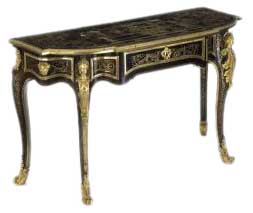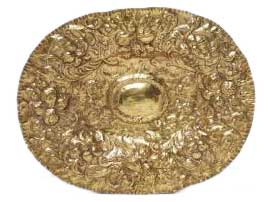French Baroque Furniture, Louis XIV Furniture
1643 - 1715
The era of King Louis XIV, or Louis Quatorze, marked the definite end of the Renaissance period in France and the beginning of a series of distinct period furniture styles, the first being the enormously influential Baroque.
The Age of Louis XIV Furniture
French Renaissance furniture, including Louis XIII furniture, had gradually undergone changes until under the patronage of Louis XIV it developed into what was probably the most magnificent of the French period styles. It was an age of courtly splendor and grandeur; of rich, massive furniture, well suited to the palace and salon and where it is used today for large, richly furnished rooms.

French Baroque Cupboard, 1700.
Ebony veneer, with marquetry of engraved pewter and brass and panels of clear horn over blue pigment, on an oak carcase.
Large cupboards in which to keep clothes and other objects had been in use in France for some time before this type of furniture was adapted in the later 17th century to serve in rooms of state. An impressive appearance could be heightened by means of the materials used, as in this example, which is finely decorated with boulle marquetry - veneers (wafer-thin sheets that are glued and then cut out to a design) in ebony, tortoiseshell, brass, pewter and horn. The Paris workshop of André-Charles Boulle (1642-1732) made the most important pieces of furniture of this kind, but this example, although of high quality, is probably the work of another cabinet-maker.
In 1660 Louis 14th adopted his title of Le Grand Monarque and became a powerful king. He aided Colbert in encouraging the arts, and gave every opportunity for development to such artists and designers as Daniel Marot, De Espouy, Hardouin Mansart, Noel Coy-pel, and Le Pautre. Great furniture designers and cabinet-makers were encouraged, and thrived, including J. Charles Berain and Andre Charles Boulle.
Boulle
Andre Charles Boulle was cabinet-maker to King Louis XIV and was one of the greatest of the ebinestes (workers in ebony), inlaying ebony wood with tortoise shell, brass and other metals until the whole resembled a brilliant mosaic. He further decorated his work with chiseled mounts of ormolu and bronze, carved and gilt ornaments. Marble and granite were used for table and console tops, and fine tapestries for upholstering; all combining to create a style in perfect harmony with the pomp and glittering splendor of the baroque Louis XIV age.

Boulle Console Table, 1701
Veneers of tortoiseshell and engraved brass, on an oak carcase, with gilt-bronze mounts.
This table is an elaborate example of boulle marquetry - thin sheets of brass and tortoiseshell veneer on an oak frame.
Characteristics
The Louis XIV style is marked by dignity, grandeur, bold effects, lavish but not excessive ornament, and faultless workmanship. In the decoration the anthemion and acanthus were prominent, and the ornamental details were symmetrical and balanced.
Tables of the Louis XIV furniture style had similar turned or pedestal feet, and later had curved legs. Small, round and oblong tables and consoles became common. Beds were designed chiefly with a view to supporting elaborate draperies. A couch, called "lit a la duchesse" gilded, painted, and varnished, made its appearance. Carved and inlaid panels were much used on chests and wardrobes, and there were many forms of chests and cabinets in vogue. One chest was shaped like a sarcophagus, after the Italian Renaissance manner, and was set on carved scroll legs, like a table, with drawers beneath. A common form of cabinet had a serpentine front and carved feet and panels, and was decorated with Buhl work. These, along with Louis XIV chairs are but a few of the numerous forms that appeared during the Louis XIV baroque furniture period.

Boulle Tables, 1701
Oak and walnut, veneered with brass and Boulle contrepartie marquetry of tortoiseshell, pewter, copper and horn, back-painted in blue pigments, with gilt bronze mounts.
Influence of History
Many historical changes took place during the 72 years' reign of Louis XIV which had a direct effect on the arts. The influence of the Queen Regent and Cardinal Mazarin during the years of Louis's minority was toward greater luxury, which always means ornateness in decoration. More powerful still was the constructive influence of Jean Baptiste Colbert, Minister of Finance, who became Prime Minister in 1661. Colbert fostered the growing art impulse among the French people and encouraged the art industries. He founded the Academy of Painters and Sculptors, organized the lace industry, and was instrumental in the government purchase of the Gobelin Tapestry Works, at the head of which he placed Charles Le Brun.
As royal works, the Gobelin factory became a powerful influence in the development of style. Le Brun became manager in 1660 and a dictator of style. In 1690 he was succeeded by Mignard. The Beauvais Tapestry Works were also established during this reign, with Louis Hyvart as manager. The tapestries produced by these two factories were typical of the tastes of the times, and were characterized by pomp and grandeur, with a preference for serious classic and martial subjects.
Under royal patronage the palace was built at Versailles and gardens were laid out by Andre Le Notre. Great artists and designers were employed in the interior decoration and furnishings, and magnificence was the keynote. In some respects, however, the work done at Fontainebleau and the Trianon, and in certain chateaux and private mansions, where a simpler phase of the Louis XIV baroque style is illustrated, forms a safer guide for modern students.
Wood
The chief woods used in cabinetmaking were oak, walnut, chestnut, and ebony, with ornamental portions frequently done in rosewood, sandalwood, tulipwood, and various exotic woods. There was much gilding, marquetry and carving, with mounts and inlay of onyx, porphyry, lapis-lazuli, ormolu, brass, and colored woods. Gobelin tapestry and Lyons velvet were the principal upholstery materials.
Late Baroque
Toward the end of Louis XIV's era the styles changed, developing toward that of the styles of Regence furniture and the Rococo period of Louis XV furniture.
The pedestal legs gave place to more slender, curved legs. Elaborate carving became an even more prominent feature, with a more graceful rococo and more scroll work. In other respects very similar to the Louis XV style, however, this late Louis XIV work continued to show balanced details, while one of the distinguishing features of the succeeding reign is a balance of harmony, but not of detail.

Mazarin Writing Desk, 1685-1700.
Marquetry of brass, ebony, ivory, mother-of-pearl and clear toroiseshell or horn with painted paper backing, on a pine carcase.
Throughout the Louis XIV period the great designers continued in their effort to perpetuate the spirit of the Renaissance. It was a distinguished period in the development of French applied art and one worth studying for its own sake, as well as for the sake of a better understanding of the styles that followed.
Antiques & Reproductions
The Louis XIV style has been somewhat neglected in the past by modern manufacturers of period furniture, who have found the styles of Louis XV and Louis XVI more popular. Of late, however, Louis XIV reproductions and adaptations have been placed on the market in increasing numbers, and today the style is enjoying something of a popular vogue. Its dignity and distinction render it suitable to the more formal rooms in modern homes.

Baroque Dish, 1680.
This Baroque style dish was intended for display on a buffet or sideboard. The Baroque style is characterised by exuberant decoration, expansive curvaceous forms and an air of solemn, sometimes pompous grandeur.
